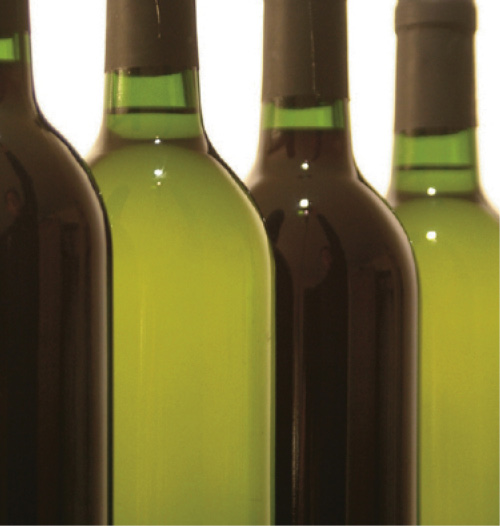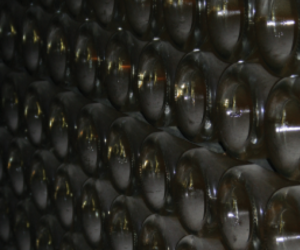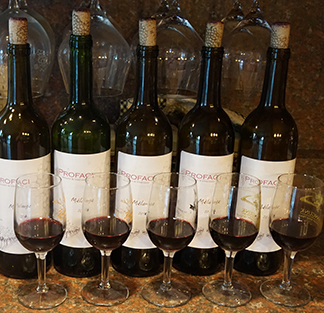
You make a wonderful batch of wine in your home winery, spending months monitoring the primary fermentation, the malolactic fermentation, carefully managing SO2 levels and additions, racking off the gross lees, minimizing exposure to oxygen. And then the day comes when you move your prize wine into bottles. You spend hours bottling the wine, thinking of the time when you’ll be able to pop one of those corks and share a glass of your homemade wine with friends and family. A week later you open the bottle and pour a glass, only to find that the wine coming out of the bottle isn’t the same one that went in! It’s “off;” it lacks complexity; it’s disjointed. Is it ruined? Nope – it’s probably just bottle shock, a temporary condition that can make the taste and aromas of your wine seem muted. The key word here is “temporary” – bottle shock will pass. But is there any way to prevent it? Three pro winemakers discuss battling bottle shock before it begins.
The Pros:
• Pat Henderson, Head Winemaker at Kenwood Vineyards in Kenwood, California
• Sabrine Rodems, Winemaker at Wrath Wines in Soledad, California
• Michael Jones, Fermentation Specialist at Scott Laboratories in Napa, California



What causes bottle shock, and what is the danger zone for bottle shock after bottling a wine following bulk aging?
Pat Henderson: I think it’s caused by a lot of things. Many times the roughest treatment a wine will get is right before bottling, for example filtering and sulfur additions. Bottle shock can take the aroma down a notch. It’s a really convenient scapegoat, however, and it is oversold sometimes (“it’s just bottle shock it’ll get better. . .”)
Sabrine Rodems: What most call ‘bottle shock’ is the dumbing down of some wine characteristics after bottling. Filtration, movement and oxidation can cause bottle shock.
Michael Jones: From recent readings on the subject it seems that bottle shock can come from oxidation — which you do get during bottling — but more from filtering prior to bottling. The filtering upsets the colloidal balance. Colloids are partially soluble elements that give body and texture to the wine. What you’re doing in filtration is breaking them apart, and it seems to take a while to recover depending on the wine. Movement at bottling can affect the wine too. I have found that it can take up to six months for a wine to recover after bottling.
Can bottle shock be accurately diagnosed in a wine? Why or why not, and how?
Pat Henderson: I’ve never really done any tests to try and diagnose it. Bottle shock, if it really is bottle shock, means the wine still has 90% of its flavor compared to where it was when you bottled, it just seems a little dull, not as vibrant; it’s subtle. If the wine is radically different than it was when you bottled, it’s probably something else. I never worry about testing or diagnosing bottle shock, that’s why we hold the bottles for a minimum of 6 to 8 weeks before releasing them, and longer for reserve. A little bit of bottle maturity can help those big Cabs too.
Sabrine Rodems: If you know what the wine tasted like before it went into bottle you can usually tell the difference after. Can most drinkers tell . . . probably not, unless they know what the wine tasted like before bottled. We forget that wine is constantly reacting to the headspace in the bottle and is engaged with the outside air via the cork and the side wall between the cork and the glass.
Michael Jones: If you’re making the wine, and it’s wonderful up until bottling and then it’s not the same wine, that’s bottle shock. It’ll be just kind of flat, lacking complexity.
Do you have any memorable bottle shock experiences? What happened and when did you figure out that it was bottle shock? How long did it take the wine to recover?
Sabrine Rodems: One of the first wines I made and bottled was a Chardonnay in stainless. It tasted great in the tank, and the day after bottling I tasted a bottle and it tasted like sour water! I said to myself, “Great, the first production wine I ever make from grape to bottle and it tastes like sour water!” . . . it recovered and so did I. Often after bottling the most pronounced component of a wine tends to stand out since the other components are dull and recovering.
Michael Jones: At one of my positions as a professional winemaker, I worked on making an expensive Chardonnay. We did a tasting a few months after bottling and it was really dumbed down — you wouldn’t have believed it was the same wine. We put it though pad and sterile filtration because it only went through partial malolactic. After six months, however, there was virtually no difference between the bottled wine and the wine we had been tasting out of the tank just before bottling.
Do you notice if different varietals tend to experience more bottle shock than others? Why do you think that is?
Pat Henderson: Pinot Noir is more sensitive to everything. Chardonnay too. Both seem to be a little more sensitive to bottle shock. I think maybe when we bottle Chardonnay we get more bottle shock as we put a lot of different barrels together.
Sabrine Rodems: Varietals do tend to react differently. I think it is for different reasons. I actually enjoy drinking my bright whites through shock because they are more acidic, which is how I like to drink them. I don’t have a problem releasing them early because of this. They will just mellow a little over time. But something like Syrah, at least with the wines I make, tend to really close down and take 10 months or so in bottle to equilibrate.
Michael Jones: I’ve seen it happen in both reds and whites — but more severely in whites. I would say whites are generally more protected from oxidation but they often go through more filtration.
Do you notice if filtration is a factor in your wines that experienced bottle shock? If so, what is your filtration process for those wines that tend to experience bottle shock? Are there other factors you have noticed that might increase the chances of bottle shock?
Pat Henderson: When we make filtration decisions, we look at what we are trying to accomplish. Ask yourself, what is the minimal amount of processing? The less you can do to a wine the more the flavor comes through. Our reds don’t get filtered as tightly as the whites, but with more tannin I think they might be more susceptible to bottle shock.
Sabrine Rodems: We sterile filter most of our wines, so I don’t have anything to compare it to, but I would say yes. Filtration is a factor in shock. It takes more time for the wine to equilibrate after shoving it through a 0.45 micron filter. Upon release date though, I don’t think filtration is a huge factor in the flavor profile of the wines.
What can a winemaker do to minimize bottle shock? (SO2 additions, stability, limiting O2 during bottling, etc?)
Pat Henderson: The best course of action to prevent bottle shock: Don’t add more sulfur than you need. Bottle as gently as possible – don’t hot-water sterilize the bottle. Don’t go crazy with additives right before bottling. And be patient if you experience bottle shock – the wine will come around with time.
Sabrine Rodems: Limiting oxygen does help, but there is no perfect machine. Our bottling line sparges the bottles at many steps throughout the process with nitrogen so the headspace is protected, but bottling can be a little rough on a wine. I would say if you experience bottle shock, just be patient and let the wine settle in bottle before drinking. This is why wineries try not to release “just” bottled wine.
Michael Jones: Treat the wine as reductively as possible and minimize O2. For instance, when racking in my home winery I run a hose with CO2 into the barrel I am pumping wine from. The CO2 fills in the vessel behind the wine I pump out. I also put a chunk of dry ice into the receiving vessel for the wine so that the gas that is given off as the wine goes in and sublimates the ice pushes out the O2 that is present.
For a home or small-scale winemaker, what can be done to prevent bottle shock, both after bottling and later if transferring?
Pat Henderson: If you experience bottle shock, just remember it’s not going to ruin your wine. It’s a disappointment, though, and you might think, “Oh my god what have I done.” Don’t panic. Unless you’ve done something really incorrect, it’ll be ok. I will take a bottle home the day of bottling from the winery and I know it’s not going to be its true self for a month or two.
Sabrine Rodems: I would say just be gentle all the way around. Shaking is oxidation, pumping is oxidation, bottling and filtering is oxidation. Just be nice to your wine. You spend all that time making it, take care of it until the very end.
Michael Jones: Be patient. For home winemakers — many of whom do not sterile filter — you will have much faster recovery time and ergo fewer problems with bottle shock.






